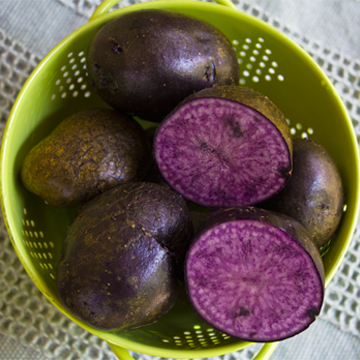In Praise of a Purple Potato
 In the last century, (about 12 years ago), Americans discovered there a color palette for potatoes instead of the standard swatch of white . There were always sweet potatoes around, but it took Yukon Golds with slightly yellow color and their buttery flavor, and to break through the American mindset that potatoes only came in white. In a country that perfected the dehydrated potato flake, I guess what else could be expected? Contrast that with Peru, where potatoes originated, potatoes come in a wide spectrum of colors. Check out this gallery from the International Potato Center.
In the last century, (about 12 years ago), Americans discovered there a color palette for potatoes instead of the standard swatch of white . There were always sweet potatoes around, but it took Yukon Golds with slightly yellow color and their buttery flavor, and to break through the American mindset that potatoes only came in white. In a country that perfected the dehydrated potato flake, I guess what else could be expected? Contrast that with Peru, where potatoes originated, potatoes come in a wide spectrum of colors. Check out this gallery from the International Potato Center.
With the interest in heirloom vegetables growing, the idea of potatoes being more than just white, is becoming more mainstream. There still is a lot of people who don't know about anything other than white potatoes.
In the late winter and early spring, the question I get is "What are you growing this year?" This year, the response included Purple Majesty Potatoes. I got a a good number of responses that were a mix of confusion and intrigue, which is one of the reasons I do what I do. I love that response. It demonstrates an interest in learning about alternatives to what they know. Since people also know that I'm a storyteller, they know there will be a good story for them to listen and learn from.
When I first learned about the Peruvian Blue potatoes, I was surprised. I had only known the white potatoes of my youth. Russets from Maine, and baking potatoes from Idaho. Once the red skin potatoes were introduced into the mix, they became a staple growing up also. I have to admit, I don't find the red skins to be all that, and will choose Yukon Golds in the supermarket over them without hesitation.
Last year, I had my first experience digging potatoes. They were of course, the red skin kind. Within 20 minutes of digging them, they were roasting in my oven. I also had enough to make some fresh gnocchi. Light as a feather, and tasty as could be, it was at this point I knew potatoes would be in my next garden. I was certain they wouldn't be white. I wanted the Peruvian blues, but as it worked out, I ended up with the Purple Majesty. I keep reading about how great the Majesty were for chips or fries. Except for some misdirected BBQ Rib flavored potato chips, there has never been a bag of chips I haven't liked.
The Purple Majesty potato is not for long term storage, and is considered a medium starchy potato. While chips and fries were the best I've ever had, shredding them and making has browns is the way to go with these. They bake well, and I've seen recipes that use them as mashed potatoes. I didn't try them as mashed because once I went hash browns, I never went back.
Growing potatoes in the ground is easy. They can grow in containers also. While I grew them in the ground, I am growing sweet potatoes in a container. I'll let you know that turns out.
